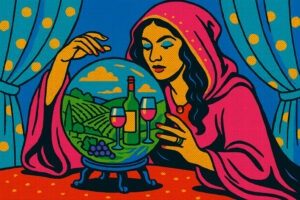
Friuli Venezia Giulia is one of the wine regions consumers rank at the top for quality still white wines. Collio, however, bordering Slovenia, a crescent shaped area stretching from Dolegna del Collio to San Floriano del Collio, is considered the most qualified area for this type of wine (as well as Soave in Veneto). The white wines of Collio (1.300 hectares of vineyards that are often the “backyards” of many small producers, and 88% of which are planted with white grape varieties), are well known to virtually everyone, while the region, instead, is not well known, or rather, it is not visited as much. There is definitely a growth potential for this “white enclave” of Italian wine, rich in history, beauty, and gastronomic gems waiting to be discovered, but needing a greater focus on promotion and communication. These are the messages the “Collio Experience” survey by Nomisma Wine Monitor conducted for the Consortium for the Protection of Collio Wines, revealed. The survey was presented recently at “Collio Evolution” in Cormons (on October 26th and 27th), the denomination’s first institutional event (with Luciano Ferraro, deputy editor of the newspaper, “Corriere della Sera”, and Denis Pantini, head of Nomisma Wine Monitor). The event was organized by the Consortium, which is led by President Luca Raccaro and Director Lavinia Zamaro (and brings together 288 companies). It is a showcase for Friulano, the quintessential wine of the Collio region, presented by more than 50 wineries across a wide range of vintages, witnesses to the evolution of a territory unique in its history and potential.
The survey that interviewed 1.500 people, revealed that Friuli-Venezia Giulia is one of the leading Italian regions in the production of quality white wines, according to 13% of regular white wine consumers, while only Alto Adige was higher (15%). The Regions of Sicily (11%), Trentino (10%), and Veneto (9%) followed. Collio ranks first among the hilly regions that produce quality white wines, together with Soave, the white wine stronghold of Veneto (13.4% of first-time respondents), followed by the Hills of San Gimignano, home of Vernaccia, in Tuscany, and the areas of Terlano, Appiano, and Termeno in Alto Adige. Nearly all Italian white wine consumers reported that they know (or have heard of) at least one of the wines produced in the Collio region, while only 53% are aware of the actual provenance of these wines. Considering the people who have consumed these wines over the past year, there is a big difference between the total number of respondents and the share of so-called “conscious consumers” (that is, those who know the wines and know they are produced in the Collio region). Moreover, this gap is greater for wines made from native grape varieties (Ribolla Gialla, Friulano), than for wines produced from international grape varieties (Pinot Bianco, Pinot Grigio, Sauvignon), which emphasizes that knowledge of the region is a lever to increase the consumer base of Collio wines. Out-of-home consumption (restaurants, wine bars) is more prevalent than in-home consumption for those who drink Collio wines. According to one out of two consumers, balance between body and freshness as well as aromatic complexity are the two main strengths that contribute the most to appreciating Collio wines.
Conscious consumers of Collio wines, (in other words, “real users”, that is, consumers who are familiar with them, aware of the correct terroir, and consider the area to be one of the most suited to produce high-quality white wines), are predominantly people that have medium-to-high incomes, highly educated, wine experts, and wine tourism enthusiasts. The survey, illustrated by Denis Pantini, also revealed that of the people who do not drink Collio wines, 46% reported that they are not familiar with them, while 24% said it was because they can’t find them in restaurants and shops they frequently go to. Nine out of 10 “non-consumers”, though, would gladly try them. Wine tourism is also a great resource for the area, and a rapidly growing phenomenon, including one out of two Italian wine consumers over the past year, according to the Nomisma survey. Percentages were higher among consumers that had a high level of education (68% of wine tourists in this “category”), medium-high incomes (66%), wine experts (63%), and millennials (63%). In these categories, 13% said they had visited Collio, but more importantly, they would be interested in returning. A future wine tourist vacation or visit to Collio is especially high among those who already consume Collio wines (43%), and it is also high among all categories of wine tourists (40%). The high percentages stem from the fact that people who have been to the area have evaluated it positively. They have expressed a high level of satisfaction of the overall experience as well as individual aspects that contributed to making it an excellent experience, such as the beauty of the landscape (positively evaluated for 94% of wine tourists), quality of the wines (90%), the organization of accommodations and the dedicated staff at the winery (83%).
The “Collio Experience” study by Nomisma Wine Monitor for the Collio Wine Consortium, concluded, “communication is becoming an important lever to further develop the region. According to the preferences Italian consumers have expressed, the most suitable methods include restaurant tastings (preferred by 21% of respondents), organizing dedicated events (17%), and wine tourism (13%). Social media and influencer recommendations have been indicated by 13% of Italian consumers in general, while among younger consumers (up to 29 years old), the number goes up to 18%”.
Copyright © 2000/2025
Contatti: info@winenews.it
Seguici anche su Twitter: @WineNewsIt
Seguici anche su Facebook: @winenewsit
Questo articolo è tratto dall'archivio di WineNews - Tutti i diritti riservati - Copyright © 2000/2025